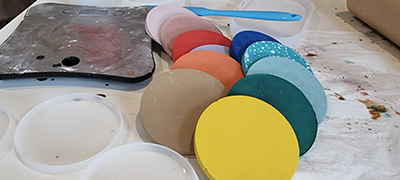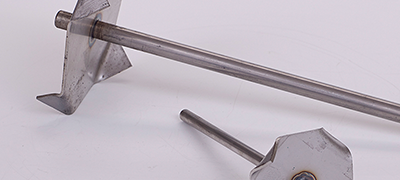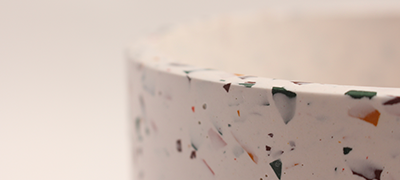Hopefully we’ve caught you just as you’re beginning to work with Jesmonite so we can give you some pointers on what we wished we’d known, but if not you might be able to relate to some of the points below!

- You’re going to make a mess. Jesmonite isn’t a clean craft and try as you might, you probably will get powder and liquid all over your work surface. Invest in a plastic cover to protect your gorgeous wooden table and make sure you add some Grimex Wipes to your next basket so you can clean up any spills!
- Don’t craft in silence. Find something you love to listen to, whether it’s your favourite album, or having Friends on in the background. Crafting should be fun and not too intense and serious!
- Invest in reusable tools. Be kinder to the environment and make life easier for yourself by investing in reusable tools. Add our mixing buckets and silicone spatulas to your next order and you’ll find yourself much better equipped.
- A little pigment goes a long way. You can add up to 2% of the overall weight to your Jesmonite mix in pigments, but be aware that if you want to create a pastel colour, you’ll need to add it drop by drop until you get the colour you want.
- Use Jesmonite AC730 for soap dishes. Soap dish moulds have become hugely popular recently, but if you use them with Jesmonite AC100, it’s likely your finished creation will mark and stain as AC100 isn’t water resistant. Even with the Acrylic Sealer, AC100 is only splash-proof. For soap dishes and any item that will be exposed to water, we’d recommend using AC730.
- Don’t leave your Jesmonite in the mould too long. With AC100 and AC300, it is possible to leave your creation in the mould too long, and it’ll then start to sweat, leaving marks and stains on your work. If you’ve used a solid black pigment you might see white lines running through your piece. We’d recommend leaving your Jesmonite AC100 and AC300 in the mould for 20-30 minutes as a good guide.
- Take some time learning how to properly finish your pieces. If you want to create something of a high standard, take a look at our sanding and sealing how-to guides to fully understand the best way to finish your creations.
- Don’t get disheartened. If something doesn’t turn out the way you wanted it to, don’t beat yourself up. Remember, everything you see on social media is a highlight reel and even experienced makers get it wrong every now and again!
- Disasters can be salvaged. Did your piece snap when you removed it from the mould? Got a tiny dot of unwanted pigment on your creation? Although you might not be able to sell them anymore, experiment with ways of salvaging your pieces using glue and a little sanding. Fix them up and give them to a friend who’s supported you free of charge. Disasters aren’t always destined for the bin!
- Experimentation is key! The best way to learn with Jesmonite is to just try it! Give it a go and have fun!
Hopefully “10 Things to Know Before Working With Jesmonite was useful”? We’d love to know what you wish you’d have known about Jesmonite before you started! Let us know on Instagram at @polysiluk and we’ll share your hints and tips with other makers!

